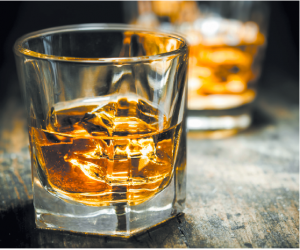 An eminent member of our profession once observed that bourbon is “the brownest of the brown liquors.” Clearly, he had a trial lawyer’s eye for detail. Sure bourbon is brown, but it is also hot. It is enjoying a renaissance in bars, backyards and boardrooms. I believe there are a lot of reasons for this: a fad for cocktails (like Don Draper’s bourbon-based Old Fashioned); a fatigue with boggy Scotches; and the joy of discovering America’s bourbon-making micro-distilleries. I drink it for a simpler reason: bourbon is brown and sweet and it packs a punch.
An eminent member of our profession once observed that bourbon is “the brownest of the brown liquors.” Clearly, he had a trial lawyer’s eye for detail. Sure bourbon is brown, but it is also hot. It is enjoying a renaissance in bars, backyards and boardrooms. I believe there are a lot of reasons for this: a fad for cocktails (like Don Draper’s bourbon-based Old Fashioned); a fatigue with boggy Scotches; and the joy of discovering America’s bourbon-making micro-distilleries. I drink it for a simpler reason: bourbon is brown and sweet and it packs a punch.
Bourbon is a type of whiskey manufactured in the United States, just like Scotch whisky (or just Scotch) is made in Scotland. (To confuse you further there’s a difference — and some debate — over spelling: “whiskey” is commonly used in the U.S. while Scots like “whisky.”) There are two things that make it distinctive: the fi rst is that, by law, it must be made with at least percent corn. The sugars in the corn make bourbon much sweeter than other whiskeys, which are made with more austere grains such as wheat, rye and barley.
The second hallmark of bourbon is oak. Most whiskeys are aged in barrels to give the spirit colour and flavour. However, most whiskey-makers are like winemakers: they approach oak with caution because a new barrel is so robust that it douses its contents in an aftershave of vanilla and musk. They prefer the subtler flavours of used oak. Not bourbon-makers. For them, “subtlety” must sound suspiciously European. Bourbon is aged in new, charred oak, giving the liquor richness, spice and (of course) brownness. As a result, bourbon makes a great cocktail because it can stand up to any number of mixes without breaking a stride. And unlike Scotch, which is muted by ice, bourbon only gets better on the rocks. It really is the brownest of the brown liquors. Just because the lawyer who said this was actually Lionel Hutz from The Simpsons (who once famously cited the case of Finders v. Keepers) doesn’t make it any less true.
Into the Short Cellar
 Woodford Reserve Distiller’s Select
Woodford Reserve Distiller’s Select
$46.95, LCBO #480624
Woodford exemplifies something vital about straight bourbon: compared with the storied single malts of Scotland, it provides outstanding value for money. At under $50, this spicy and complex spirit is punching well above its weight. It is remarkably elegant for a bourbon, making it more of a sipping whiskey rather than a flashy mixer. 91/100
 “Devil’s cut” Jim Beam
“Devil’s cut” Jim Beam
$32.95, LCBO #272161
For those who find that there’s not enough bourbon in their bourbon, Jim Beam has created “Devil’s Cut.” It’s made by extracting the whiskey absorbed into the wood of used barrels, supercharging it with the pungent and smoky taste of oak. But for all its machismo, this straight bourbon has a smooth, easy finish. 89/100
Brown Liquor Lingo
If you’re browsing for bourbon, here’s some vocabulary that will help your hunt
- Sour mash is a key process in distilling bourbon. Like making sourdough bread, the distiller adds leftover mash from a previous batch to the new one, keeping it safe from bacteria and ensuring the taste is consistent.
- Straight bourbon means the whiskey has no artificial colours or flavours, and that it’s been aged in barrel for a minimum of two years. If you’re going to buy bourbon, make sure it is straight bourbon.
- Tennessee whiskey is a special designation for bourbon whiskey made in that state. It goes through an extra step, getting filtered through sugar-maple charcoal. This is what makes Jack Daniel’s taste a little softer than the usual
Matthew Sullivan is a civil litigator in Toronto. Email matthew@lawandstyle.beta-site.ca.
Photo: Daniel Reiter/iStockphoto

